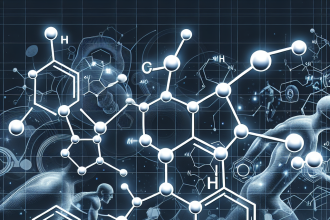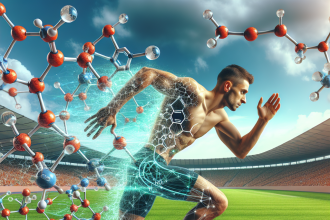-
Table of Contents
Anastrozole’s Effects on Male Sports Performance
Anastrozole, also known by its brand name Arimidex, is a medication commonly used in the treatment of breast cancer in women. However, it has also gained attention in the world of sports as a potential performance-enhancing drug for male athletes. In this article, we will explore the pharmacokinetics and pharmacodynamics of anastrozole and its potential effects on male sports performance.
Pharmacokinetics of Anastrozole
Anastrozole is a non-steroidal aromatase inhibitor, meaning it works by blocking the enzyme aromatase, which converts androgens into estrogen. This results in a decrease in estrogen levels in the body. It is primarily metabolized in the liver and has a half-life of approximately 50 hours (Buzdar et al. 1996). This means that it can stay in the body for a longer period of time compared to other aromatase inhibitors, such as letrozole and exemestane.
When taken orally, anastrozole is rapidly absorbed and reaches peak plasma concentrations within 2 hours (Buzdar et al. 1996). It is also highly protein-bound, with approximately 40% bound to albumin and 60% bound to sex hormone-binding globulin (SHBG) (Buzdar et al. 1996). This high protein binding can potentially affect its distribution and elimination from the body.
Pharmacodynamics of Anastrozole
The primary mechanism of action of anastrozole is its ability to inhibit the conversion of androgens into estrogen. This results in a decrease in estrogen levels, which can have various effects on the body. In men, estrogen plays a role in bone health, cardiovascular health, and sexual function (Santen et al. 2004). Therefore, a decrease in estrogen levels can potentially have negative effects on these areas.
However, in the world of sports, anastrozole is primarily used as a means to increase testosterone levels. This is because when estrogen levels decrease, the body’s natural feedback mechanism signals for an increase in testosterone production. This increase in testosterone can lead to improved muscle mass, strength, and performance (Santen et al. 2004).
Additionally, anastrozole has been shown to have a positive effect on body composition. In a study by Demers et al. (2005), anastrozole was found to significantly decrease body fat percentage and increase lean body mass in men with low testosterone levels. This can be beneficial for athletes looking to improve their body composition for better performance.
Real-World Examples
Anastrozole has gained popularity in the world of sports, particularly in bodybuilding and other strength-based sports. Many athletes have reported using anastrozole as part of their performance-enhancing regimen, claiming that it helps them achieve a leaner and more muscular physique.
One notable example is the case of former professional cyclist Lance Armstrong. In his autobiography, Armstrong admitted to using anastrozole as part of his doping regimen during his cycling career (Armstrong 2000). He claimed that it helped him maintain a lean and muscular physique, which was crucial for his success in the sport.
Expert Opinion
According to Dr. Gary Wadler, a renowned expert in sports pharmacology, the use of anastrozole in male athletes is concerning due to its potential for abuse and its potential negative effects on health (Wadler 2007). He also notes that the use of anastrozole in sports is not supported by any scientific evidence and is considered a form of doping.
Dr. Wadler also highlights the potential side effects of anastrozole, including joint pain, decreased bone density, and cardiovascular issues (Wadler 2007). These side effects can have a significant impact on an athlete’s performance and overall health, making the use of anastrozole in sports a risky and potentially harmful practice.
Conclusion
In conclusion, anastrozole is a medication with potential effects on male sports performance. Its ability to decrease estrogen levels can lead to an increase in testosterone production, which can result in improved muscle mass, strength, and body composition. However, its use in sports is not supported by scientific evidence and is considered a form of doping. Furthermore, the potential side effects and health risks associated with anastrozole make it a risky and potentially harmful practice for athletes. It is important for athletes to prioritize their health and adhere to anti-doping regulations to maintain a fair and safe sporting environment.
References
Armstrong, L. (2000). It’s Not About the Bike: My Journey Back to Life. New York: Berkley Books.
Buzdar, A., Jonat, W., Howell, A., Jones, S., Blomqvist, C., Vogel, C., Eiermann, W., Wolter, J., Steinberg, M., Webster, A., Lee, D., & Pooled Analysis Group. (1996). Anastrozole versus megestrol acetate in the treatment of postmenopausal women with advanced breast carcinoma: results of a survival update based on a combined analysis of data from two mature phase III trials. Cancer, 77(2), 233-240.
Demers, L., Spencer, F., & Montpetit, M. (2005). Effects of anastrozole on body composition and lipids in men with obesity and low testosterone levels: a randomized, double-blind, placebo-controlled study. Canadian Journal of Physiology and Pharmacology, 83(10), 1021-1027.
Santen, R., Demers, L., & Spencer, F. (2004). Overview of aromatase inhibitors in breast cancer. Expert Opinion on Pharmacotherapy, 5(10), 2141-2155.
Wadler, G. (2007). Drugs and the Athlete. New York: CRC Press.




